In 2025, search engine marketing will see shifts driven by AI and user behavior. Google is placing ads within AI Overviews, semantic search is influencing how ads appear, broad-match keywords will have a bigger role, and Video Action campaigns are transitioning to Demand Generation campaigns.
This blog outlines the key trends shaping SEM in 2025, their impact, and practical strategies to adapt.
Search and Shopping Google Ads in AI Search Overviews in 2025
Since May 2024, Google has been testing placing search and shopping ads before and after the AI-generated overview content. However, in 2025, Google plans to feature ads within the AI content.
As an example, you can see in the image below that those searching for solutions to unwrinkle clothes will see shopping ads for products that do exactly that:
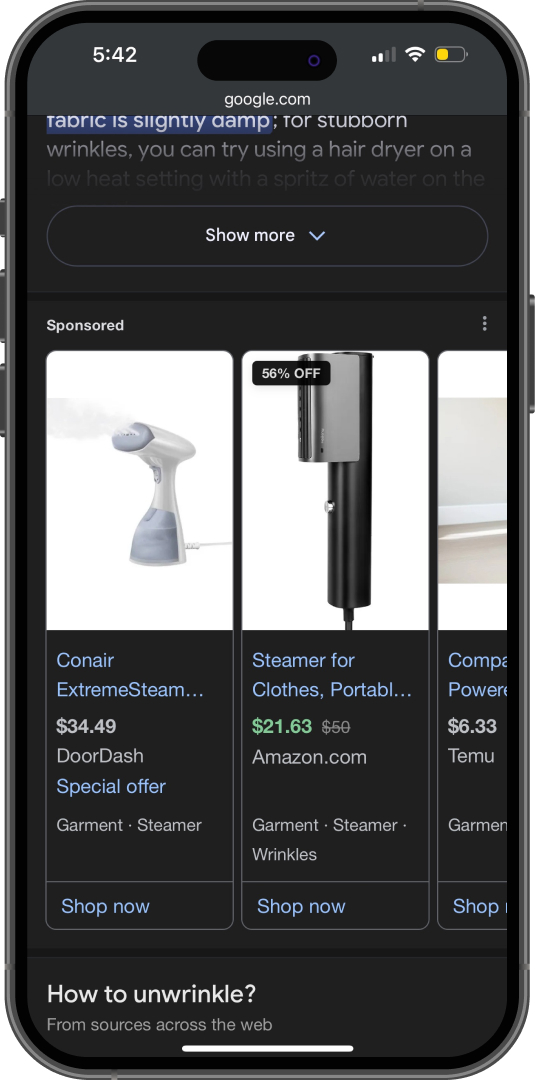
So far, there are no specific criteria for your ads to be placed within the AI content overview. However, following the best practices and implementing the recommendations mentioned here should help you optimize for this:
- Increase the number of long-tail conversation keywords
- Have more conversational ads that are to the point
- Address specific queries or issues
- Use natural language
- Focus on Ad Rank components like Quality Score and relevance
Zero-Click Searches
Less than 60% of Google searches actually lead to a click due to Google’s featured snippets and answer boxes.
People are now more accustomed to quick, short, and direct answers with the help of ChatGPT, Bing Chat, Gemini, and Perplexity.
That means lower traffic for both organic and paid search results, which means a decrease in click-through rate and an increase in the cost per click.
Search engines now favor semantic and contextual targeting over traditional keyword targeting, which you can leverage using broad match keywords (covered in the next section). This will allow your ads to reach a bigger audience and increase your chance of getting more clicks at a lower cost.
Shift From Keyword-Based to Semantic Search & The Power of Broad Match Keywords
Keywords are not going away, but semantic search will have more impact on whether your ads show for a specific keyword or not.
Semantic search is a search engine technology that shows ads based on its interpretation of the keywords and the intent behind them based on the users’ behavior rather than the actual keyword. So, 2 people could type the same search query and see different results depending on their previous searches, their search context, geographical context, and the user intent.
For example, the search query “Football” means one thing in the US and another in the UK. So, depending on the user’s location and the semantic search technology, each user will see location-relevant results.
Another example: if you search for running shoes and then delete your search query and type the word “black,” Google will suggest queries based on your previous search.
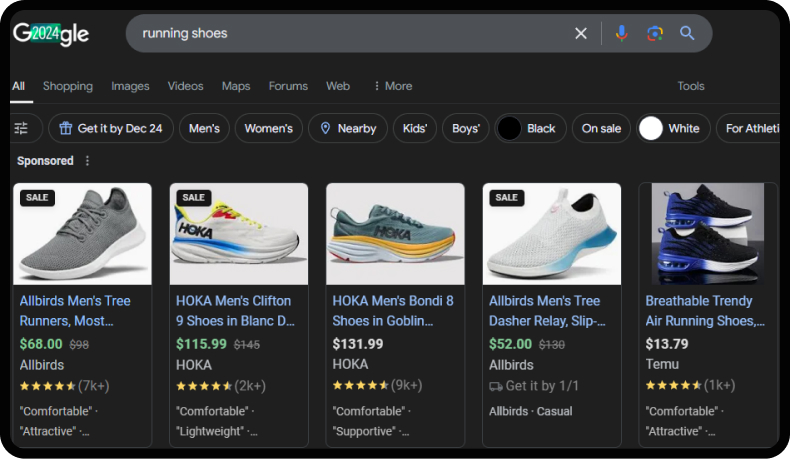
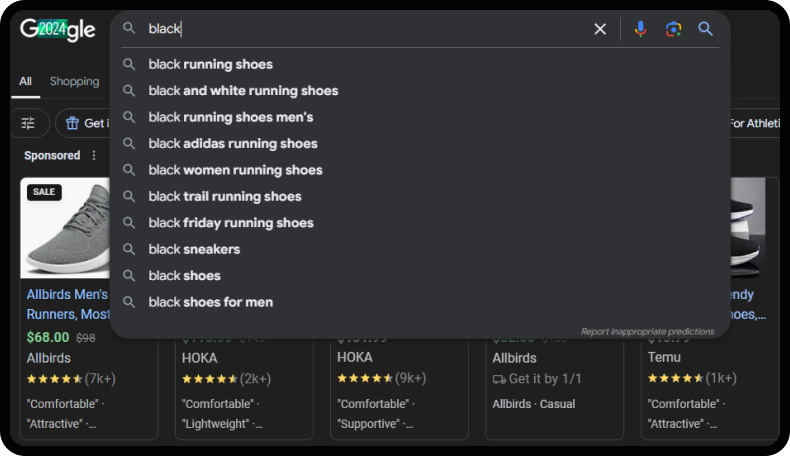
To make sure that your ads appear in the right context and for the correct intent, you’ll need to utilize more broad-match keywords.
Exact and phrase match types restrict the ads to show only for specific/similar searches, while broad match keywords utilize the semantic search technology and include searches that don’t contain the keyword terms, allowing you to reach more relevant searches than with exact and phrase matches.
But with broader reach, comes greater responsibility. Broad match keywords require regular search term filtering to exclude irrelevant search terms and guide the keywords toward the relevant ones.
We have also seen cases where it consumes all of the budget, not leaving enough for exact and phrase-match ones. That can be resolved by one of the solutions mentioned here in the broad match testing guide – adding the broad match keywords to their own campaign with their own budget while excluding the phrase and exact matches from that campaign to prevent overlapping.
Keywordless Strategy & PMax Optimizations
As mentioned above, Google is transitioning from keyword-based – which sometimes would cause your ads to appear for similar keywords but with the wrong intention – to intent-based, and it wouldn’t be a surprise to see a full keywordless approach coming in the near future.
The Performance Max campaign is already using a similar approach, where you can add search themes and audience signals, but Google leverages its AI and machine-learning capabilities to find potential customers for your goals and serve the most appropriate ad, with the optimal bid, to maximize campaign performance.
Despite not using traditional keywords for targeting, you can still optimize your performance max campaigns using the following:
Review Assets Performance
By using the ‘View Details’ option from the ‘Asset Groups’ menu, you can see how Google ranked each asset in terms of performance, the number of conversions, and the conversion value. You can then place the ones with low performance and low/zero conversions.
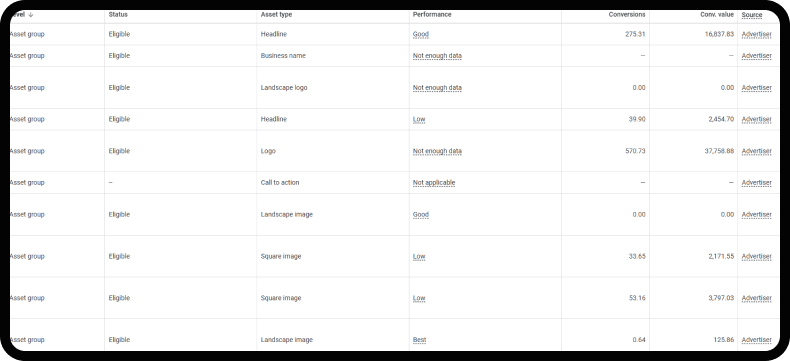
For eCommerce: Ensure all Your Products are Ready to Serve
That sounds like a no-brainer but focusing on targeting, assets, budget, and bidding strategy can easily distract you from checking whether your products are actually ready to serve or if there’s an issue with the feed or the information being passed from your online store to Google.
Asset Group Segmentation
Segment your asset groups based on product categories if you have an eCommerce business, or based on your services if it’s a B2B business.
That will help you create more relevant ads using relevant ad copy and ad assets. It would also be good if you promote your main product/service with their own campaigns so you can have more control over budget allocation.
Audience Signal Testing
A/B test audiences promoting the same assets, services, and product categories and monitor their performance.
AI won’t understand what success means for your business till you add your inputs, like valuable conversion actions, correct bidding strategy type depending on whether you care the most about the cost per lead or ROAS, and finally audience signals.
Sunsetting Video Action Campaigns Will Put Demand Gen at the Forefront for YouTube Ads
Starting in Q2 2025, advertisers will no longer be able to create YouTube Video Action Campaigns, and all the existing ones will auto-transition to Demand Generation campaigns.
The reason for that is that Google noticed that advertisers who ran video ads with Demand Gen saw a similar number of conversions to their Video Action campaigns at a similar cost per action as well.
So, by using a multi-format strategy, you see even better results.
In terms of features, here’s what you can expect from Demand Gen:
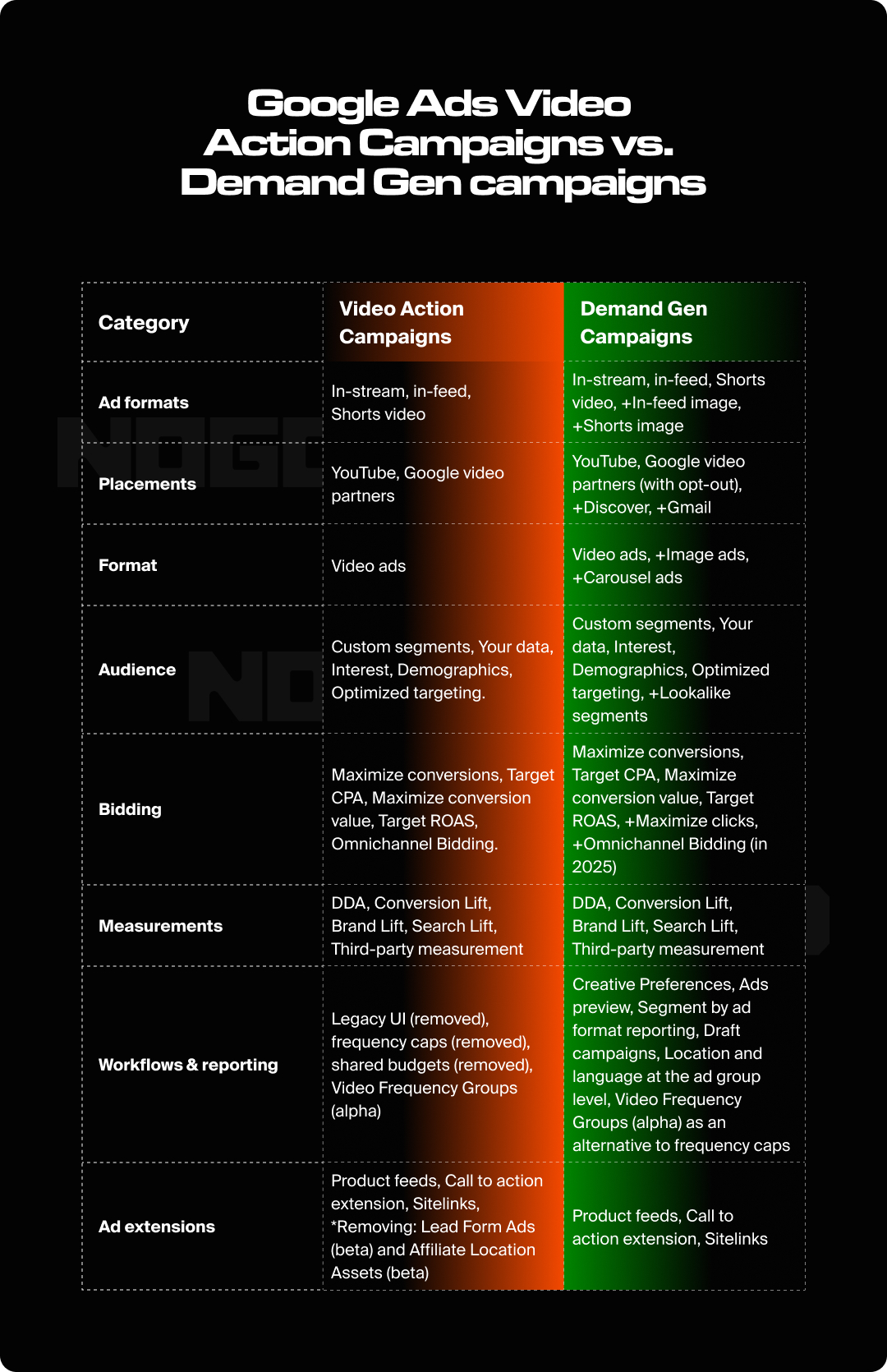
Tips for Running Effective Demand Gen Campaigns
Use a Combination of Videos & Images
Demand gen campaigns serve ads across YouTube, Discover, Gmail, and Google video partners, so using both images and videos in your ads is crucial to maximizing your reach across all the available inventory.
Provide Google AI With the Right Assets
Google recommends following the rule of 3. In each ad group, add at least 3 images or videos in each aspect ratio (vertical, square, and landscape) to maximize your reach across all placements.
It’s recommended that your assets feel natural and don’t look like ads. If you’re going to run a YouTube short as an ad, make sure it feels and looks authentic and connects with the viewers like the organic ones.
Use a Smart Bidding Strategy Type
Choose a bidding strategy that aligns with your goal. If your goal is leads, then you should choose to Maximize Conversions, and when you have enough conversions, you can set a target cost per action (tCPA), depending on your actual CPA.
If your goal is sales, then you should choose Maximize Conversion Value, and when you have enough conversions, you can set a target ROAS (tROAS).
You can also use Maximize Conversion Value if your goal is leads if you have different categorizations for your leads and each one has its own value, like MQLs and SQLs. Normally SQLs have a higher value than MQLs; in that case, using Maximize Conversion Value will allow Google to focus on the conversions with higher values – SQLs.
A/B Test Audiences
Demand Generation campaigns accept different types of audiences, like custom segments, your data segments, lookalike segments, and interest-based.
The variations here are limitless – you can test each one in its own ad group, test combining all of them, combine some of them, go nuts!
As a best practice, give your audience/campaign a minimum of 2 weeks before making a final decision, and document your findings so you don’t repeat your tests.
New Platforms
Social Search Engines
Reddit, TikTok, and Pinterest aren’t really search engines, and they aren’t considered SEM channels. However, a study shows that 40% of consumers use TikTok as a search engine. That’s because the content is being delivered through short, direct, and informative videos with good storytelling.
Expand your reach by utilizing various platforms beyond Google and Bing ads and direct your audience to your website. Share concise tutorials or product demonstrations on social media, and participate in relevant Reddit communities.
Making ads that look like any normal post on any of these platforms will drive more engagement. It’s not always about selling a product or a service; it’s also about educating your audience.
Think of the reasons why your audience uses these platforms. 62% of TikTok users favor video tutorials above other formats, 39% use the platform for reviews, and 38% use it for anecdotes. That brand awareness through tutorials and reviews will keep your brand at the top of their minds and that will benefit you greatly when they’re ready to purchase.
Answer Search Engines
Answer Search Engines like ChatGPT, Claude, Perplexity, etc, are designed to give you direct answers to your questions without your having to do the search on your own and go from one website to another. I’m sure you understand why it’s compelling for users.
As marketers, we run our ads where the paid impressions are, and if users are using Answer Engines, we should too.
Perplexity started experimenting with ads on its platform; the site will show the ads in the US as a start, and they will be formatted as “sponsored follow-up questions,” (e.g. “How can I use LinkedIn to enhance my job search?”). These ads will be positioned to the side of answers and labeled as “sponsored.”
So far, no other platform announced that they will show ads any time soon, but we encourage you to start testing ads on these platforms once they become available.
Final Thoughts: Adapting to the Future of Search Engine Marketing
In 2025, search engine marketing will see changes driven by AI and user behavior. From integrating ads into AI-generated content to adapting to semantic search and using broad match keywords, marketers have new ways to optimize strategies.
The move to Demand Generation campaigns for YouTube Ads focuses on multi-format strategies and audience targeting, while updates in Performance Max campaigns provide more transparency and control.
By understanding these shifts and applying best practices, advertisers can adjust and achieve better results in an evolving search environment.






